
There’s no escaping it: AI in digital marketing is rewriting the rules. But while there’s plenty of hype around the “next big thing,” there’s surprisingly little clarity on actual value. At the end of the day, most of us just want to know: How will this save time and make money?
Between burnout, endless new tools, and fear of missing out, it’s easy to feel overwhelmed. But here’s the reframe: AI isn’t magic – it’s leverage. And it does two things exceptionally well:
- It makes marketing faster and easier.
- It makes personalization, automation, and prediction possible at scale.
This isn’t about tools. It’s about results. So, let’s cut through the noise and dive into five AI marketing strategies you can use right now to simplify your workflow, boost conversions, and grow faster in 2026.
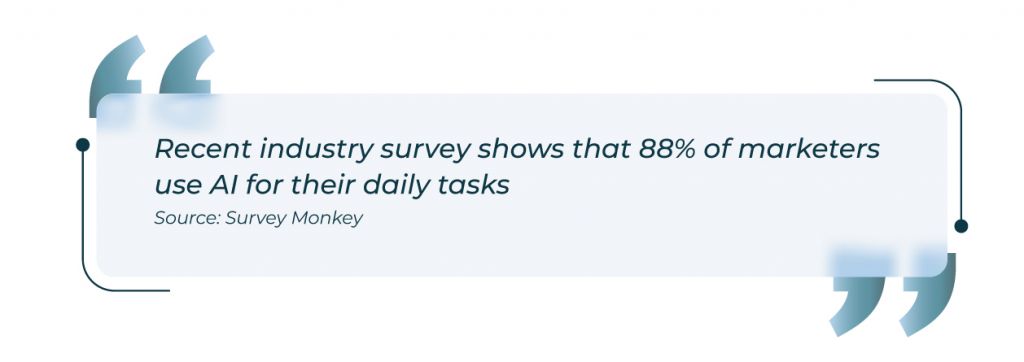
See how these shifts started taking hold in: The Future of AI Driven Marketing
AI-Powered SEO Strategies for 2026: Rank Smarter with Generative AI
Search is changing fast, and traditional search keyword-based SEO just won’t cut it in 2026. The next evolution of AI in digital marketing is about intent, context, and conversation. That’s where AI-powered SEO strategies come in, helping you optimize not just for search engines, but for how people actually ask questions.
You can also explore our blog AI Is Driving SEO in 2025 – Here’s How to Use It, which details how AI is already influencing keyword strategy and ranking models.
What is GEO (Generative Engine Optimization)?
GEO, or Generative Engine Optimization, is the new frontier of SEO. As generative AI for marketers becomes standard, your content needs to be optimized not just for Google’s algorithms but for AI-powered search tools like SGE (Search Generative Experience), ChatGPT, and Gemini that deliver conversational answers directly to users.
Deeper dive on query design: Understanding Keyword Strategy in the World of Generative AI
Here’s how GEO alters the SEO playbook – and how you can use it to your advantage:
- Optimize for questions, not just keywords. Focus on natural, conversational phrasing: what users are asking, not just what they’ve typed.
- Prioritize context over density. AI search rewards clarity and structure more than keyword stuffing.
- Provide structured answers. Use schema, lists, and FAQs so AI engines can easily extract your content into summaries or featured results.
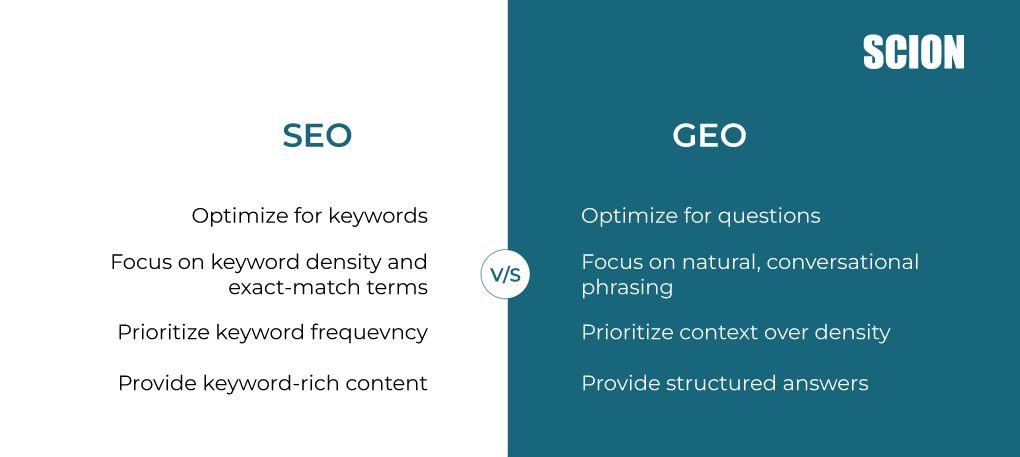
This isn’t about gaming search engines. It’s about making your content the most useful response in a world where machines read first.
You can use AI to:
- Cluster keywords by intent and search stage: Instead of manually sorting lists, ask AI to group keywords by where your audience is in their journey; from early “what is” searches (awareness) to comparison queries (consideration) to purchase-focused terms (decision). This gives you a roadmap for content that meets users at every step.
- Identify conversational queries and featured-snippet opportunities: Use AI tools to analyze “People Also Ask” data and voice-search phrasing to uncover the real questions your audience types or speaks. Then, structure your answers clearly so your content can appear in snippets and AI-generated summaries.
- Generate schema markup, meta titles, and FAQ content: AI can write and format this technical SEO data for you, including JSON-LD schema, optimized meta descriptions, and concise FAQs that help search engines (and AI assistants) interpret your pages accurately.
Prompts to try:
- “Cluster these 50 keywords by search intent and suggest article titles for my website [website URL here]”
- “Write SEO meta descriptions under 155 characters for [topics].”
- “Find 10 questions my audience might ask about [industry].”
Pro tip: End your prompt with “Before you begin, ask me any questions that will help you improve your output.” You’ll be surprised how dramatically this simple addition can improve the results you get.
These prompts can save hours of manual research and ensure your content aligns with how users and AI search models interpret intent.
Recommended tools & how to use them
- Ahrefs: Find out where your content appears in AI overviews and chats like ChatGPT, Gemini, and Perplexity – then refine your SEO strategy based on those insights.
- ChatGPT + SEO Plugins: Use ChatGPT with SEO plugins to cluster keywords, generate meta data, and rewrite content for clarity and tone.
- Google SGE Labs: Use it to preview how AI-generated results interpret your content, then refine your pages for conversational visibility.
Related execution ideas: How to Approach Website Design in 2024 (with AI-led UX considerations)
The takeaway:
AI makes SEO less about chasing algorithms and more about understanding intent. When you use AI to enhance empathy and context, you don’t just rank higher. You resonate deeper.
AI Content Generation for Marketing: Build Scalable Content Pillars That Convert
If content creation feels like a never-ending grind, here’s a gamechanger. AI content generation for marketing can help you work smarter, turning one idea into an entire content ecosystem – all without sacrificing quality.
How AI supports content creation
- Generate topic ideas and outlines: Start by feeding your main concept or keyword into AI, which can quickly produce structured outlines, subtopics, and content angles to guide your writing from the very beginning.
- Turn one idea into a multi-format content pillar: A single blog post can be repurposed into social media posts, email newsletters, LinkedIn carousels, and short videos. Why work harder when you can work smarter?
Hands-on walkthrough: AI-Powered Writing: Unlocking Potential with Copy.ai
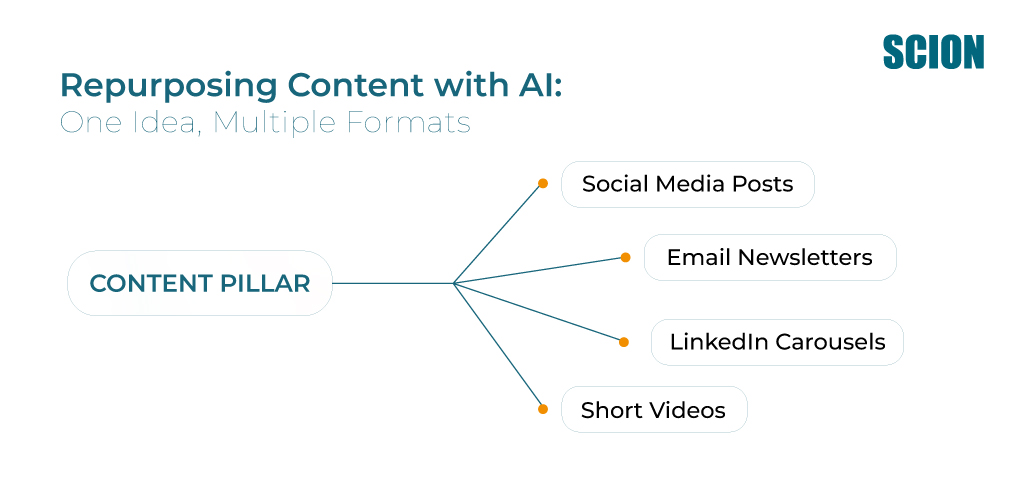
Prompts to try:
- “Create a blog outline targeting [keyword].”
- “Turn this blog post into 5 Instagram captions and 3 LinkedIn hooks.”
- “Write a video script based on this blog with a catchy opening hook”
Remember, AI is your co-writer, not a ghostwriter. Let it help with research, outlines, tone, and repurposing while you stay in creative control. With your expertise and brand voice guiding it, you ensure every piece remains authentic and high-quality.
Recommended tools & how to use them
- Copy.ai: Generate blog outlines, drafts, social captions, and ad copy quickly. Use it to structure your content and maintain consistent messaging across channels.
- Descript / OpusClip: Repurpose long-form content into short videos, Reels, or social clips, easily expanding a single idea into multiple formats.
- ChatGPT + Canva Plugin: Brainstorm visual concepts and create supporting graphics, carousels, or infographics that align with your content pillars.
The takeaway:
AI clears your content clutter so your creativity can shine. By streamlining the entire workflow, from ideation to repurposing, you can create more, reach more, and stay consistent – all while keeping full creative control.
AI for Social Media Marketing: Multiply Your Reach with Smart Automation
Guesswork is out. AI for social media marketing is in. AI marketing strategies and marketing automation with AI can help you plan, create, and publish content smarter AND faster, so you can grow engagement consistently without burning out.
How AI supercharges your social media marketing
- Spot trends, craft hooks, and time posts perfectly: AI tools analyze your industry, audience behavior, and trending topics to suggest the best content ideas and posting schedule.
- Repurpose and schedule content automatically: Transform one piece into multiple formats and have it published across platforms with minimal effort.
- Personalize engagement at scale: Adapt captions and messaging for different audience segments, ensuring that the tone and style match each platform while staying consistent.
Prompts to use:
- “Find top 5 trending topics in [industry] this week.”
- “Write 10 high-engagement hooks for a [product/service].”
- “Suggest optimal posting time for audience: [region + persona].”
Recommended tools & how to use them
- Predis.ai: Discover trending topics and generate post ideas tailored to your audience.
- FeedHive: Plan, schedule, and analyze content performance across multiple social channels.
- Metricool: Track engagement metrics, optimize posting times, and evaluate campaign effectiveness.
- Canva Magic Studio: Design graphics, carousels, and visual posts quickly from AI-generated content ideas.
- Rephrase.ai: Produce short-form video content by turning text or blog content into personalized videos.
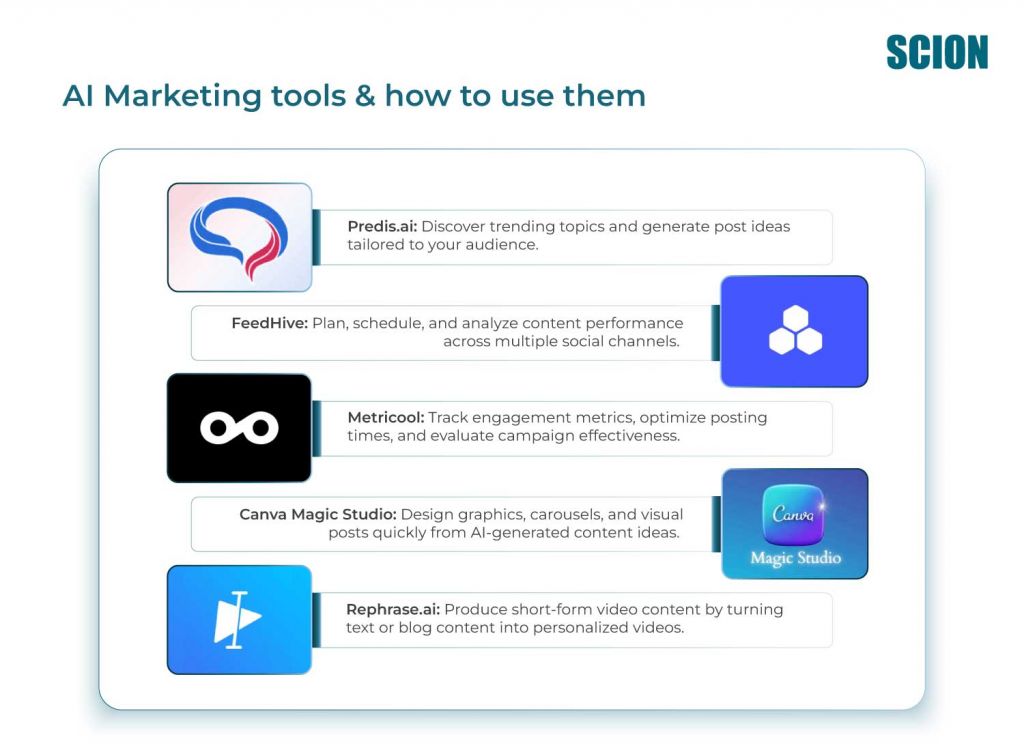
The takeaway:
AI can become your 24/7 content strategist – no burnout, just consistency. Automate trends, scheduling, repurposing, and personalized engagement so you can grow your reach, stay consistent, and focus on strategy while AI handles the heavy lifting.
AI in Customer Engagement: Personalize Every Interaction with Conversational AI Chatbots
Customer interactions can make or break a business – and that’s where AI in customer engagement shines. Conversational AI chatbots and AI personalization at scale let you respond smarter, faster, and more personally, turning every interaction into a time saver, a conversion booster, and a way to make your brand feel genuinely human.
How to use AI to enhance customer engagement

- Move beyond old chatbots: Unlike rule-based bots, conversational AI chatbots understand context, maintain a natural flow, and provide personalized responses tailored to each customer.
- Train bots with your brand knowledge: Feed AI FAQs, tone guidelines, and product information to ensure every interaction reflects your voice and expertise.
- Anticipate behaviour with predictive logic: AI can suggest relevant offers, answer questions before they’re asked, and guide users toward the next step, increasing conversions and reducing support load.
Prompts to use:
- “Create a conversational chatbot flow for customer onboarding.”
- “Summarize FAQs into chatbot dialogue.”
- “Simulate a natural conversation for first-time visitors.”
Recommended tools & how to use them
- ManyChat AI: Build automated conversational flows for onboarding, lead generation, and support.
- Tidio: Personalize live chat interactions using AI-driven suggestions and automation.
- Intercom Fin AI: Automate customer support with context-aware responses while maintaining a human tone.
- Zapier + ChatGPT Automation: Connect AI chatbots to your apps and workflows for seamless, automated responses.
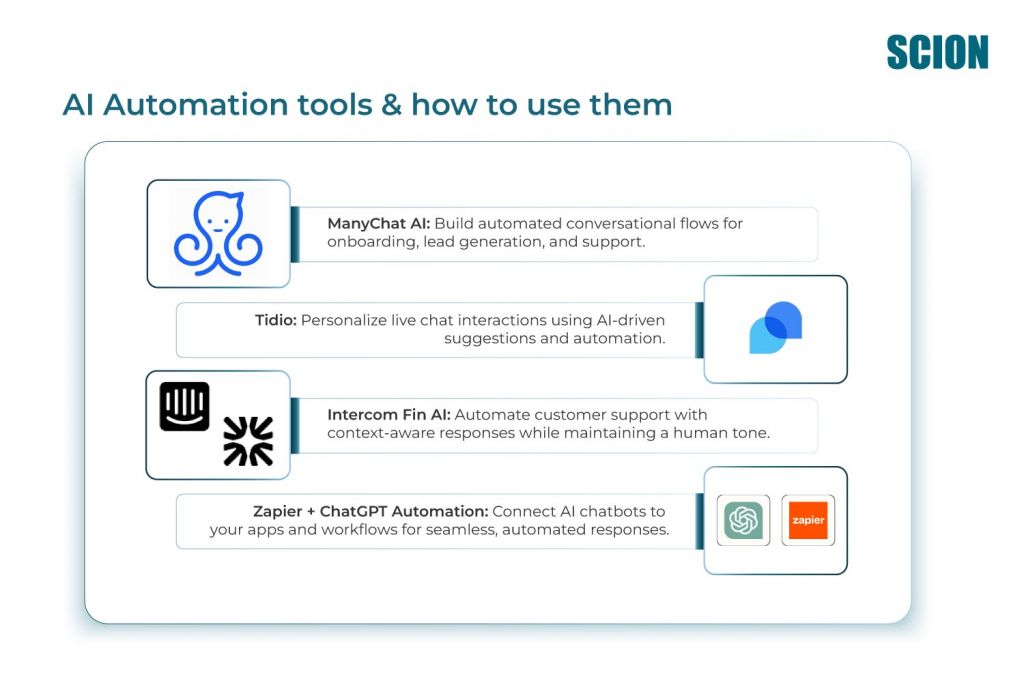
The takeaway:
AI can make customer engagement feel personal, even at scale. By using conversational AI chatbots and AI personalization, you can reduce support load, anticipate customer needs, and turn interactions into conversions – all while keeping your brand’s voice front and center.
Predictive Analytics in Marketing: Using AI to Turn Data into Decisions
Data is only as valuable as the insights you can act on. With predictive analytics in marketing and smart AI marketing strategies, you can turn raw numbers into clear recommendations.
Picture this: You upload a CSV and AI replies: “Your email CTR rose 24% this week; replicate last Thursday’s subject line style.”
The result? Instant insight, plus immediate action.
How to use AI to transform marketing analytics
- Consolidate and export your marketing data: Gather data from Google Ads, Meta, GA4, CRM systems, and other channels so that AI has a complete picture to analyze.
- Upload and process data with AI tools: Platforms like ChatGPT (Advanced Data Analysis), Gemini, or Claude.ai can interpret complex datasets in seconds.
- Summarize insights and highlight opportunities: AI detects anomalies, tracks trends, and even generates presentations or reports, turning raw numbers into actionable recommendations.
Prompts to use:
- “Analyze this data and show top campaigns by ROI.”
- “Summarize this report into 5 slides for an investor presentation.”
- “Suggest key metrics to track for [goal].”
Recommended tools & how to use them
- ChatGPT (Advanced Data Analysis): Analyze large CSVs, summarize trends, and generate insights automatically.
- Gemini / Claude.ai: Advanced predictive analytics and data interpretation for marketing performance.
- SheetGPT / PromptLoop: Connect spreadsheets directly to AI to automate reporting and analysis.
- Beautiful.ai / Tome.app: Turn AI-generated insights into visually compelling slide decks or presentations.
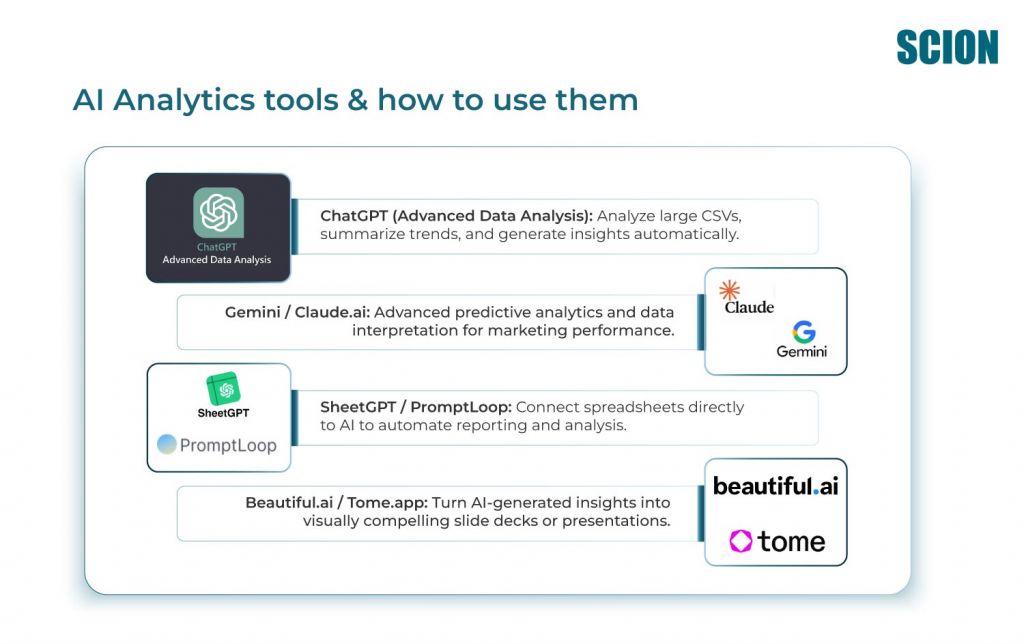
The takeaway:
AI doesn’t just analyze; it explains your numbers and turns them into stories. Through predictive analytics and smart AI marketing strategies, even the dullest data can be transformed into actionable insights.
Practical Steps to Implement AI Marketing Strategies Today
AI marketing strategies don’t have to be overwhelming. Even small experiments can deliver big results.
- Pick a challenge: Focus on a specific area like SEO, content creation, or social media.
- Run a 30-day AI experiment: Test tools, prompts, and workflows to discover what works for your team.
- Measure hours saved and results gained: Track efficiency, engagement, conversions, or other relevant KPIs.
- Scale only what works: Double down on successful experiments and expand AI integration gradually.
Remember: Generative AI for marketers isn’t here to replace creativity, but to amplify it. Embed this video here
FAQ’s: AI in Digital Marketing
In 2026, AI is fully integrated across the marketing landscape. Businesses use AI for predictive analytics, content creation, SEO optimization, personalized customer engagement, and social media strategy. It helps automate repetitive tasks, uncover insights from large datasets, and create personalized campaigns at scale, all while enabling marketers to focus on strategy and creativity.
AI allows marketers to identify trends, optimize posting times, craft high-engagement content, and personalize messaging for different audience segments. With AI for social media marketing and marketing automation with AI, brands can maintain consistent engagement, expand reach, and reduce the time spent on repetitive tasks.
Using AI in customer engagement involves deploying conversational AI chatbots and AI personalization at scale. Train chatbots with FAQs, tone, and brand knowledge, and let AI anticipate user behavior to suggest offers or guide customers. This reduces support load, improves response times, and turns interactions into conversions – all while keeping your brand voice authentic.
Strategies that focus on automation, personalization, predictive analytics, and content optimization consistently improve ROI. For example: automating social media scheduling, using AI to personalize email campaigns, leveraging AI-powered SEO strategies, and testing content with AI A/B experimentation all deliver measurable results while saving time and resources.
AI supports SEO and content creation by identifying search intent, generating keyword clusters, optimizing meta titles and schema, and suggesting featured snippets. In content creation, AI content generation for marketing streamlines ideation, outlines, tone adjustments, and multi-format repurposing, enabling marketers to produce more high-quality content faster.
The more relevant data you provide, the better AI performs. Typical inputs include website analytics (GA4), CRM data, advertising performance (Google Ads, Meta), social media engagement, and historical campaign metrics. Clean, structured, and complete data ensures AI can generate accurate insights and actionable recommendations.
Not at all. AI amplifies human creativity rather than replacing it. Automation handles repetitive tasks, analysis, and content repurposing, freeing marketers to focus on strategy, storytelling, and creative problem-solving. The best results come from a collaboration between AI efficiency and human insight.
Small businesses can start by focusing on one area at a time, such as social media automation, AI-driven content generation, or predictive analytics. Many affordable AI tools (like ChatGPT, Copy.ai, FeedHive, or Metricool) offer free tiers or pay-as-you-go plans. Running small experiments, measuring results, and scaling only what works ensures maximum ROI without overspending.
Conclusion
Using AI in digital marketing delivers two big wins: efficiency and innovation. It helps you work smarter, create more, and uncover opportunities you might have missed.
Start small, track the results, scale what works, and you’ll turn AI from hype into a real growth engine for your business.
Want to see it in action? Subscribe to our FutureReady AI Newsletter for real-world examples of how entrepreneurs are using AI in digital marketing.
